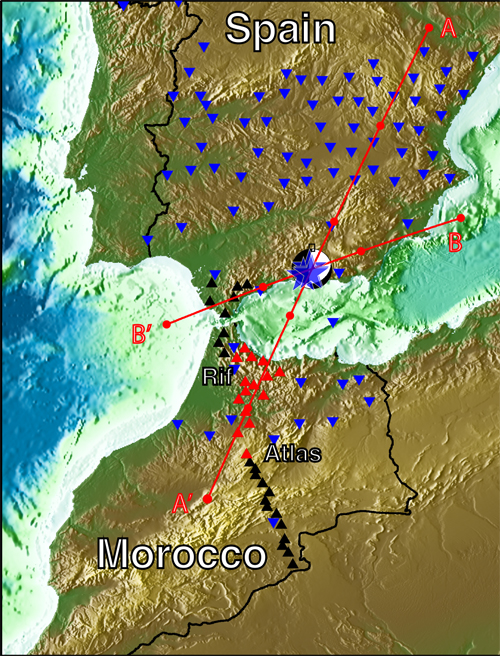21 February 2024–Strange seismic wave arrivals from a 2010 earthquake under Spain were the clues that led to an unexpected discovery beneath the western Mediterranean: a subducted oceanic slab that has completely overturned.
The waveforms paint a picture of a slab that descended rapidly into the Earth’s mantle and flipped over, so that the water it carried on its surface as it descended is now beneath the slab, according to the study published in The Seismic Record.
The findings could help researchers sort out the complicated tectonic structure of the western Mediterranean basin where Africa and Eurasia are converging, specifically an area called the Rif-Betic-Alboran region. This region contains an arc formed by the Betic mountain ranges in Spain and the Rif mountain ranges to the south in Morocco and includes the Alboran Sea basin just east of the Straits of Gibraltar.
The study might also shed light on the mechanisms behind rare and deep (more than 600 kilometers) earthquakes in southern Spain, write Daoyuan Sun of the University of Science and Technology of China and Meghan S. Miller at Australian National University.

Seismic waves from one of those earthquakes, a magnitude 6.3 quake that occurred below Granada in April 2010, were captured by an array of seismic stations in Spain and Morocco as part of the Program to Investigate Convective Alboran Sea System Overturn (PICASSO) project.
The researchers noted that the earthquake’s coda waves—the signature of residual vibrations at the end of a seismogram—lasted an unusually long time, recorded by stations in Morocco. There were also signs of a late-arriving, “extra” P-wave phase, in addition to the normal initial P-waves captured by the stations in Spain.
“Initially, we were not aiming to better understand the deep earthquake mechanisms, as several prior studies have studied the source nicely. Our intent was merely to plot the waveforms out of curiosity, since there is so much to learn from individual waveforms when one takes the time to look at them closely,” Sun explained. “Upon examination, we observed these strange arrivals, including the long coda and extra phase.”
Sun and Miller concluded that the long coda and extra P-wave phase could be best explained by a low-velocity layer at the base of the subducting Alboran slab. Low-velocity layers, through which seismic waves are slowed and absorbed, often indicate that the waves have passed through melted or liquid material.
Subducted slabs usually contain a low-velocity layer on their surface due to the water they carry into the mantle. “Here, through modeling the detailed waveforms, we are able to image the low-velocity layer underneath the slab surface dipping to the northeast, unlike a normal subducted slab with a low-velocity layer on top of the slab surface,” Sun said. “This strange occurrence between the slab and low-velocity layer suggests the occurrence of the overturned Alboran slab.”
Their study is the first to conclude that the slab has been overturned, he added, rather than standing vertical or steeply dipping.
The low-velocity layer also offers a possible mechanism behind the deep Spain earthquakes, the researchers said, since it indicates the presence of hydrous magnesium silicates that carry water at depths of 600 kilometers. As these silicates dehydrate, they could become more brittle in a way that can lead to deep earthquakes.
The presence of hydrous silicates could also tell seismologists something about the speed of slab subduction in the region. The hydrous magnesium silicates mean that “a significant amount of water has been carried down to the mantle transition zone, indicating a relatively cold slab,” Sun noted.
“Considering a relatively young sea floor age in the western Mediterranean, for the slab to remain cool, the subduction speed must be quite fast, such as a moderate speed of about 70 millimeters per year,” he added. “In other words, we think our study could offer a reasonable lower bound of the speed of subduction in this region.”
Sun and Miller say it could be promising to investigate the seismic waveforms produced by deep earthquakes in other places such as northeastern China, South America, Sunda-Banda and places like the Fiji-Tonga region, to see if similar mechanisms are at work. But the research would require dense seismic stations deployed right above these earthquakes, as was the lucky case with the 2010 Spain earthquake.
